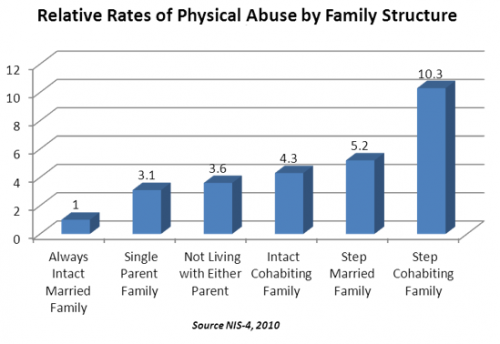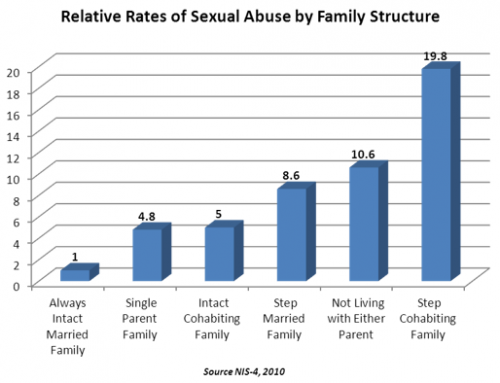Table of Contents
Effects of Family Structure on Child Abuse
Today, more Americans live in a manner that separates the bearing and raising of children from traditional marriage. This undermines the well-being of children. Since 1950, the Index of Belonging for U.S. teenagers—the number of teens raised in an intact married family, has decreased from 63 percent to 46 percent.1) The United States increasingly is becoming a country of second-, third-, and even fourth-generation marriage-less “families.” In such circumstances, as the research shows, children are most likely to suffer abuse and neglect, and new subcultures of abuse are more likely to be established.
1. The Intact Married Family
Child abuse is the opposite of child love. The married family is based deliberately on a decision by the husband and wife to build their lives and family on the love they have for each other, made public in a solemn contract before God and community. Abuse is higher when the structure of family love is rejected or broken. Measuring the differential impact of these family structures in the national surveys (intended to guide the country and its leaders on public policy) is therefore essential, and will have grave implications for the life and death of many children in the United States.
Although the sexual act can be an occasion of great intimacy and love resulting in new life, it also can be a violent or meaningless act resulting in profound alienation and fragmentation of the family. Among America's poor, the latter is increasingly the case. In 2013, 70.5 percent of children living below poverty were raised in non-intact families.2) These poorest of the poor, more than anyone else, need the support of an intimate community and can least afford the community's destruction. The children of the poor have the greatest need for married families, yet they are the least likely to have them.
Traditionally, the variable used to explain a rise in the incidence of child abuse has been poverty. The National Incidence Study of Child Abuse and Neglect illustrates this pro-poverty bias.3) However, Richard Gelles of the University of Rhode Island Department of Sociology, a recognized expert on abuse, has shown that it is the presence or absence of adult support that makes the greatest difference in determining whether child abuse is likely to be present or absent within poor families.4)
The Fourth Incidence Study of Child Abuse and Neglect has also confirmed that marriage provides the safest environment for children. This federal survey shows that the family environment with the lowest risk ratio for physical abuse is the intact married family:
- The rate of physical abuse is 3 times higher in the single parent family.
- The rate of physical abuse is 4 times higher if mother is cohabiting with the child’s biological father (unmarried).
- The rate of physical abuse is 5 times higher if the child is living in a married step family.
- The rate of physical abuse is 10 times higher if the mother is cohabiting with a boyfriend.
For sexual abuse the rates are even higher. Compared to the always intact married family:
- The rate of sexual abuse is 5 times higher in the single parent family and when both biological parents are cohabiting (i.e. unmarried).
- The rate of sexual abuse is 8.6 times higher if the child is living in a married step family.
- The rate of sexual abuse is 20 times higher if the mother is cohabiting with a boyfriend.
2. The Non-Intact Family
According to the professional literature, an abusing family tends not to be the traditional American family–that is, one in which the biological parents are married and raising their own children together. Members of an abusing family often fight over infidelity, and the primary parent frequently will change partners, causing stressful rearrangements of major family responsibilities and conflicts over the children. Other characteristics of these families include poor communication skills, inappropriate expectations of their children, and frequent alcohol and drug abuse.
Children with cohabiting parents are twice as likely to see their parents break up compared to children with married parents.5) This type of instability often leads to behavioral problems. One study found that 15.7 percent of children from cohabiting households experienced behavioral problems in adolescence, compared with only 3.5 percent of children with married parents.6) “Normal” and stable families typically exhibit a more healthy environment, as fewer teenage girls in married households initiate sex at a younger age or get pregnant as teens.7) Abuse can be tied to poverty, community, and marital status, even though not all poor, single, inner-city parents become abusers.
2.1 Abusive Men
The intergenerational continuation theory of child abuse also affirms that a boy severely abused by his father is very likely to become a violent adult.8) Specifically, one-third of sexually abusive men were sexually abused as a child.9) Men who had witnessed conjugal violence and had experienced parent-child aggression as boys are more likely to use physical and verbal aggression in their relationships.10) Moreover, the effects of these early experiences with abuse and violence begin to show up at the beginning of their relationships with women in later years. One study found that wife batterers received significantly less love, more punishment from their mothers, and less attention from their fathers, than did men in a general population.11) Growing concerns about date rape should lead investigators to explore the early family histories of abusing males in more detail.
For abusing men, violence frequently is a way to regain what they see as their lost control of a relationship.12) Conflict over children is likely to provoke this sense of a loss of control, and even to lead a couple to blows.13) Additionally, abusing men tend to have more health concerns (including depression, paranoid ideation and more), feel more stress about parenting, and feel less empathy for their children.14)
2.2 Abusive Women
Contrary to public perception, research shows that the most likely physical abuser of a young child will be that child's mother, not a male in the household, although the mother's plight often is complicated by her relationship with a cohabiting male. Abusive mothers frequently are isolated and lack the parental and extended family or peer support that is necessary to maintain their self-esteem and to buffer the stress of raising children.15) Women with higher levels of community involvement have lower feelings of psychological aggression and are less likely to abuse their child.16) Without this support, they often seek care and comfort from their children, treating these children as if they were older than they really are. When children fail to provide this support, the mother can become impatient, angry, and sometimes abusive, even when the child is only a crying infant. Others find any social stimulation from their babies (whether smiling or crying) to be much more irritating than normal mothers do.17) Their abuse in turn adds to their anxiety and feelings of helplessness.18) If the woman is a second-generation or later generation out-of-wedlock mother, or if she is a teenager, she is less likely to know what the appropriate expectations of a young child should be.
Child-abusing mothers tend to have a distorted view of their children. Not surprisingly, they judge them more negatively than do outsiders and tend to ignore their good points, focusing only on transgressions. Typically, they often see their children's transgressions as more serious than they actually are. The good in their children they ascribe to circumstances, but the bad they ascribe to their character. They tell their children what not to do rather than what to do, and they use force and physical punishment much more frequently than do most other parents.19)
Child-abusing women also lack self-esteem and strength of will (termed “poor ego strength” by psychologists). They are more likely to be guided by their environment than by their own intentions (referred to as “greater external locus of control”). They are more depressed, feel rejecting of their children more often, withdraw from them often, use anger to control them, and, in general, show less affection toward them.20) The child rejected by the mother frequently gets the most abuse.
Child-abusing women often had poor quality relationships with their own mothers and experienced mother-daughter physical abuse as a child. Additionally, women who had been with partners for a short amount of time were more likely to physically abuse their children.21)
The abusing mother is more likely to function at a lower intellectual level–with less ability to reason and understand her children and with fewer appropriate ways to handle them–than the nurturing mother.22) John Bowlby of London's Tavistock Institute, one of the world's leading experts on the mother-infant relationship, concluded in a 1986 article that the absence of an early infant attachment between mother and daughter increases the likelihood that the daughter, as an adult, will abuse her own children.23)
2.3 Intergenerational Abuse
The most likely causes of child abuse by a mother, in fact, can be traced to the violence and substance abuse present in the mother's childhood, followed by the stress and discord in her current household. A woman with a history of child abuse, and who lived in a violent community and had lower authoritarian parenting styles has a more serious risk for intergenerational transmission of child abuse.24) This is capped by her own victimization,25) and leads to increased illness and a hypersensitivity to the annoyances that children cause.26) In the period between her early experience with abusing parents and her later experiences with an abusing “mate,” the future abusing mother frequently becomes more aggressive and deviant, developing a hostile and rebellious way of acting. She will associate more with men of similar hostility and eventually will “marry” them, becoming an abused spouse herself.27)
Children are at risk of being abused if they are in families in which they see abuse. Thus, child abuse often is linked closely to abuse of the mother. Significantly, in one study, 90 percent of women residing in shelters for battered women and children said their children were in the same room or the next room while they were being abused.28) This is telling because abused mothers were eight times more likely to hurt their children when they were being battered than when they were safe from their violent partners.29)
Considering this type of family background, it is no wonder that abusing families30) and mothers31) often are the most isolated. Increasingly, this isolation is most evident in the poorest neighborhoods in the United States. According to the NIS-3 survey, these communities have the highest incidence of serious abuse.32)
Tragically, changes in community moral norms over the past five decades are reflected in the profile of the child-killing mother. As compared with her counterpart 50 years ago, the mother who kills her children today is younger, has more children, and exhibits less of a conscience.33) In addition, many of her children are born out of wedlock. The next generation of child abusers is being formed in this environment, and many will never know that children can be treated differently.
Ricky Finzi-Dottan, and Galit Harel, “Parents’ Potential for Child Abuse: An Intergenerational Perspective,” Journal of Family Violence 29, no. 4 (2014): 397-408.
This entry draws heavily from The Child Abuse Crisis: The Disintegration of Marriage, Family, and the American Community.

